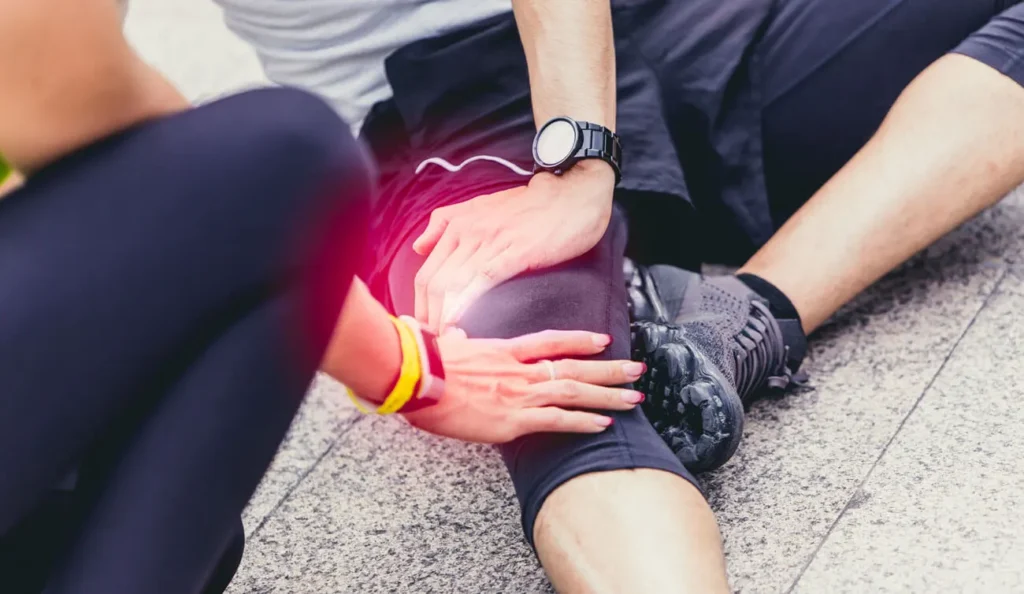Leg cramps, often referred to as charley horses, are a common and painful condition that affects people of all ages. These involuntary muscle contractions typically occur in the calf muscles but can also affect the thighs and feet. While leg cramps are usually harmless, they can cause significant discomfort and disrupt daily activities or sleep. This comprehensive guide aims to provide a detailed understanding of leg cramps, including their causes, symptoms, treatment options, and when to seek medical attention.

Content
What Are Leg Cramps?
Leg cramps are sudden, involuntary contractions of one or more muscles in the leg. These cramps often strike without warning and can vary in intensity from mild to severe. They are most commonly experienced at night (nocturnal leg cramps) but can also occur during the day, especially after physical exertion.
Common Characteristics
- Sudden Onset: Leg cramps often occur suddenly and without warning.
- Duration: They can last from a few seconds to several minutes.
- Pain: The pain is usually sharp and intense, often described as a tight knot in the muscle.
- Location: Most frequently occur in the calf muscles but can also affect the thighs and feet.
Causes of Leg Cramps
Leg cramps can be triggered by various factors, ranging from benign to serious underlying conditions. Understanding these causes is crucial for effective prevention and management.
Common Causes
- Muscle Fatigue: Overuse of muscles during physical activity, especially in athletes or those engaging in strenuous exercise.
- Dehydration: Inadequate fluid intake can lead to electrolyte imbalances, contributing to muscle cramps.
- Electrolyte Imbalances: Low levels of potassium, calcium, and magnesium are known to cause cramps.
- Prolonged Sitting or Standing: Staying in the same position for extended periods can cause muscles to cramp.
- Improper Footwear: Wearing shoes that do not provide adequate support can strain leg muscles.
Medical Conditions
- Peripheral Artery Disease (PAD): Reduced blood flow to the legs can cause pain and cramps, especially during physical activity.
- Diabetes: Poor blood sugar control can lead to nerve damage (neuropathy), causing leg cramps.
- Kidney Disease: Impaired kidney function can result in electrolyte imbalances, leading to cramps.
- Hypothyroidism: An underactive thyroid can cause muscle weakness and cramping.
- Pregnancy: Hormonal changes and additional weight can increase the frequency of leg cramps.
Symptoms of Leg Cramps
While the primary symptom of leg cramps is sudden and intense muscle pain, other associated symptoms can provide clues to the underlying cause.
Common Symptoms
- Sharp, Intense Pain: Usually localized to the affected muscle.
- Hard Lump: The cramped muscle may feel like a hard knot.
- Tightness and Tenderness: The muscle may remain sore after the cramp subsides.
- Limited Mobility: Difficulty in moving the affected leg or standing on tiptoe.
Associated Symptoms to Watch For
- Swelling: Persistent swelling may indicate a more serious condition.
- Redness and Warmth: These can be signs of an infection or deep vein thrombosis (DVT).
- Frequent Recurrence: Regular occurrence of leg cramps warrants a medical evaluation.
- Weakness: Muscle weakness accompanying cramps may suggest an underlying neurological disorder.
When to Worry About Leg Cramps
While occasional leg cramps are usually harmless, certain signs and symptoms should prompt a visit to the doctor.
Red Flags
- Severe and Persistent Pain: If the pain is excruciating and does not subside, seek medical attention.
- Swelling and Redness: These symptoms may indicate a blood clot or infection.
- Frequent Episodes: Recurrent cramps can signal an underlying medical condition that needs evaluation.
- Numbness or Tingling: These sensations may suggest nerve involvement.
- Muscle Weakness: Persistent weakness after a cramp could indicate a neurological issue.
Diagnosis of Leg Cramps
To diagnose the cause of leg cramps, healthcare providers will typically start with a thorough medical history and physical examination. Additional tests may be ordered based on the suspected underlying cause.
Diagnostic Steps
- Medical History: Includes questions about lifestyle, physical activity, hydration, and any existing medical conditions.
- Physical Examination: To assess muscle strength, tenderness, and signs of swelling or redness.
- Blood Tests: To check for electrolyte imbalances, kidney function, and thyroid levels.
- Imaging Studies: Ultrasound or MRI may be used to evaluate blood flow and detect any structural abnormalities.
- Nerve Conduction Studies: To assess for nerve damage or dysfunction.
Treatment of Leg Cramps
Treatment for leg cramps focuses on relieving pain, addressing the underlying cause, and preventing future occurrences.
Immediate Relief
- Stretching: Gently stretching the cramped muscle can help relieve the pain. For calf cramps, dorsiflexing the foot (pulling toes towards the shin) is effective.
- Massage: Massaging the affected muscle can improve blood flow and reduce tightness.
- Hydration: Drinking water or an electrolyte solution can help replenish lost fluids and minerals.
- Heat Application: Applying a warm towel or heating pad can relax the muscle.
- Cold Application: Ice packs can reduce inflammation and numb the pain after the cramp subsides.
Long-Term Management
- Regular Stretching: Incorporating regular stretching exercises, particularly for the calf muscles, can prevent cramps.
- Hydration: Ensuring adequate fluid intake, especially during physical activity.
- Balanced Diet: Consuming a diet rich in potassium, calcium, and magnesium.
- Footwear: Wearing supportive shoes to reduce strain on leg muscles.
- Exercise: Engaging in regular physical activity to improve muscle tone and circulation.
Medical Treatments
- Medications: In some cases, medications such as muscle relaxants or antispasmodics may be prescribed.
- Treating Underlying Conditions: Managing conditions like diabetes, kidney disease, or thyroid disorders can reduce the frequency of leg cramps.
- Supplements: If deficiencies are identified, supplements like magnesium or potassium may be recommended.
Prevention of Leg Cramps
Preventing leg cramps involves a combination of lifestyle modifications and addressing any underlying health issues. Here are some effective strategies:
Lifestyle Changes
- Stay Hydrated: Drink plenty of fluids throughout the day, especially during and after exercise.
- Maintain a Balanced Diet: Ensure your diet includes foods rich in essential minerals like bananas (potassium), dairy products (calcium), and nuts (magnesium).
- Regular Exercise: Incorporate exercises that improve muscle strength and flexibility, such as yoga or Pilates.
- Stretching Routine: Stretch your legs before and after physical activity and before bedtime to reduce the risk of nocturnal cramps.
- Proper Footwear: Wear shoes that provide adequate support and cushioning, especially during exercise.
Managing Medical Conditions
- Control Blood Sugar Levels: For diabetics, maintaining optimal blood sugar levels can prevent neuropathy-related cramps.
- Monitor Kidney Function: Regular check-ups to ensure proper kidney function and manage any related electrolyte imbalances.
- Thyroid Health: Regular thyroid function tests and appropriate treatment for hypothyroidism.
- Medication Review: Discuss with your doctor any medications that might contribute to leg cramps and explore alternatives if necessary.
Alternative Therapies for Leg Cramps
In addition to conventional treatments, some people find relief from leg cramps through alternative therapies. While scientific evidence may be limited for some of these methods, they can be beneficial when used alongside traditional treatments.
Acupuncture
Acupuncture involves inserting thin needles into specific points on the body to relieve pain and improve muscle function. Some studies suggest it can help reduce the frequency and severity of leg cramps.
Chiropractic Care
Chiropractic adjustments can help improve overall body alignment, potentially reducing muscle strain and preventing cramps.
Herbal Remedies
Certain herbs like valerian root, chamomile, and turmeric have anti-inflammatory and muscle-relaxing properties that may help alleviate leg cramps.
Homeopathy
Homeopathic remedies such as cuprum metallicum and magnesia phosphorica are sometimes used to treat muscle cramps, although their efficacy is still a topic of debate among healthcare professionals.
Conclusion
Leg cramps are a common yet often painful condition that can disrupt daily life and sleep. Understanding the causes, symptoms, and treatment options is crucial for effective management and prevention. While most leg cramps are harmless, it’s important to recognize when to seek medical attention for potential underlying conditions. By adopting healthy lifestyle habits, staying hydrated, and addressing any medical issues, you can reduce the frequency and severity of leg cramps.

Alina Smith is a health blog author with an interest in the intersection of wellness and mental health. She’s worked as a writer, editor, and communications specialist for various healthcare organizations. Alina has also led projects to improve access to care for underserved populations in both rural and urban settings.







